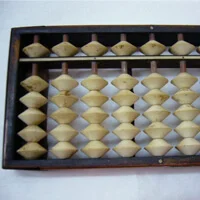There are several types of abacuses (or abaci) used throughout history and across different cultures. The most popular ones are from China, but there are other abacus that were developed independently. This article gives glimpse of some of the popular abacus.
Types of abacus
1. Chinese Abacus (Suanpan)
The Suanpan typically has 2 beads on the upper deck and 5 beads on the lower deck per rod. It is commonly used for addition, subtraction, multiplication, division, and even square roots. The Suanpan can represent numbers in both base 10 and hexadecimal (base 16) systems. The combination of the upper (5s) and lower beads (1s) allows efficient representation of numbers and calculations.

2. Japanese Abacus (Soroban)
The Soroban is simpler, having 1 bead on the upper deck and 4 beads on the lower deck per rod. Designed for quick decimal-based calculations (base 10). It’s commonly used in Japan and emphasizes speed and efficiency, especially for calculations such as addition, subtraction, and multiplication. The Soroban is optimized for use with decimal systems, and its layout reflects the modern preference for speed in basic arithmetic operations.

3. Russian Abacus (Schoty)
Unlike the Chinese and Japanese versions, the Russian Schoty typically has 10 beads per rod, with no separate upper and lower decks. It’s often used for counting in base 10. Calculations are performed by sliding the beads left or right, which differs from the up-and-down movement in the Asian abacuses. The Russian abacus is mainly used for addition and subtraction, with a simpler structure suited for quick commercial arithmetic.

4. Roman Abacus
An ancient Roman abacus had grooves in which counters or beads could slide to represent numbers. It often had a series of horizontal lines or grooves to represent different place values (units, tens, hundreds). Used in ancient Rome for calculations, this abacus was designed for Roman numerals and base 10 arithmetic. Its layout is adapted to Roman numerals, which makes it unique compared to more modern decimal abacuses.

5. Nepohualtzintzin (Mesoamerican Abacus)
This abacus, used by the Aztecs and Maya, features rows of beads arranged in a 13-row by 7-column grid. It was used to perform calculations in base 20, aligning with the Mesoamerican numeral system. The use of base 20 makes it different from most other abacuses and reflects the Mesoamerican numeral system.

Using Abacus
The most common chinese abacus has a rectangular frame divided into two parts: the upper and lower decks. Each rod on the abacus has beads, usually five in total. In the upper deck, there are two beads, each representing the value 5, while the lower deck has five beads, each representing 1. A horizontal bar separates the upper and lower decks. Beads are moved toward this bar during calculations.
All beads should be pushed away from the horizontal bar before starting any calculation. In this default position, the abacus represents zero.
Addition
Move the beads toward the bar to represent numbers. For example,
- 1 to 4: Move one to four beads from the lower deck toward the bar.
- 5: Move one bead from the upper deck toward the bar.
- 6 to 9: Move the upper deck bead for 5, and add lower deck beads to make up the rest (e.g., 6 = 5 + 1).
Subtraction
To subtract, move the beads away from the bar. For example, to subtract 3 from 8, move 3 lower deck beads back to their original position, leaving 5 beads (8 – 3 = 5).
Multiplication
Break the multiplication problem into smaller steps by using repeated addition. For example, to multiply 3 by 4, add 3 four times using the beads.
Division
Division is performed by repeated subtraction. For example, to divide 12 by 3, subtract 3 from 12 repeatedly until you reach 0, counting the number of subtractions.








